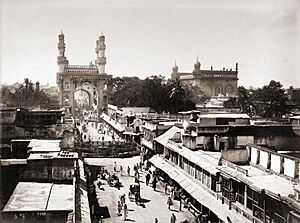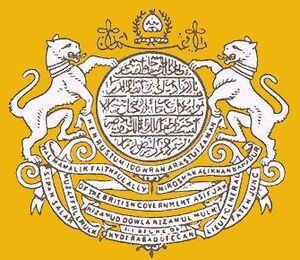History of Telangana facts for kids
The history of Telangana is a long and interesting story about a region in India. Telangana is located on the high Deccan Plateau. Over many centuries, different powerful families and empires ruled this land. Some of the most important rulers included the Satavahana Dynasty (from 230 BCE to 220 CE), the Kakatiya Dynasty (1083–1323), and the Asaf Jahi dynasty (1724–1950).
In 1724, a ruler named Nizam-ul-Mulk took control of Hyderabad. His family, known as the Nizams, ruled the princely state of Hyderabad for a long time. They built the first railways, postal services, and modern universities in Telangana.
After India became independent in 1947, the Nizam did not want to join India. But in 1948, the Indian army took control of Hyderabad State. In 2014, Telangana became the 29th state of India. It has 33 districts, and Hyderabad is its capital. Hyderabad also serves as the capital for Andhra Pradesh until 2024.
Contents
Early History of Telangana
Satavahana Dynasty
The Satavahanas became a strong power after the Mauryan Empire ended. A place called Koti Lingala is thought to be one of their 30 cities. Old coins and structures found there show that people lived there even before the Satavahanas. Coins of Simukha, who started the Satavahana dynasty, were also found.
During this time, the Deccan region was a busy place for trade. The area between the Godavari and Krishna rivers had many ports. People were very active in business and trade. Buddhism was popular, and the rulers also followed ancient Vedic traditions. They built many Buddhist stupas and temples. The Satavahanas were good rulers who loved reading and building. The 17th ruler, Hāla, was a great poet. His book "Gathasaptasati" was very popular.
The Satavahana Empire lasted for about 456 years, from the 2nd century BC to the 2nd century AD. Their empire covered most of southern India. When the Satavahana Empire fell, the region became unstable. Many small kingdoms appeared until the Western Chalukyas rose to power.
Kakatiya Dynasty

The Kakatiya dynasty became powerful in the 12th and 13th centuries. They are famous for their amazing buildings like Warangal Fort, Ramappa Temple, Thousand Pillar Temple, and Kota Gullu.
At first, they were loyal to the Western Chalukyas. But a ruler named Prola II (1110–1158) expanded his land and declared independence. His successor, Rudra (1158–1195), built Warangal Fort as a second capital. The next ruler, Ganapati Deva (1199–1262), was the greatest Kakatiya ruler. He united almost all the Telugu-speaking areas under one empire.
One of the most famous rulers was Rani Rudrama Devi (1262–1289). She was one of the few queens in Indian history. She was a strong fighter and ruler. She defended her kingdom and earned respect from other rulers. The famous traveler Marco Polo visited India during her rule.
After Rudrama Devi, her grandson Prataparudra II became king. He fought many battles and expanded his kingdom. He also made many changes to how the kingdom was run.
In 1309, the Sultan of Delhi, Alauddin Khilji, sent his army to the Kakatiya kingdom. His general, Malik Kafur, attacked Warangal in 1310. Prataparudra decided to surrender and agreed to pay a tribute.
Delhi Sultanate Takes Over
In 1323, another Delhi Sultan, Ghiyath al-Din Tughluq, sent his son Ulugh Khan to Warangal. This attack led to the end of the Kakatiya dynasty. Prataparudra was captured and sent to Delhi.
Soon after, in 1330, the Musunuri Nayaks, who were army chiefs for the Kakatiyas, united different Telugu groups. They took back Warangal from the Delhi Sultanate and ruled for about 50 years. Later, these new kingdoms joined the Bahmani Sultanate and the Vijayanagara empire.
Bahmani and Deccan Sultanates
The Bahmani Sultanate ruled the region in the 15th century. In 1463, Sultan Muhammad Shah Bahmani II sent Sultan Quli Qutb-ul-Mulk to Telangana to calm things down. Sultan Quli succeeded and became the administrator of the region. He built a strong base at the Kakatiya hill fort of Golconda. By the end of the century, Quli ruled from Golconda.
In 1518, the Bahmani Sultanate broke into five different kingdoms. Sultan Quli declared independence and started the Golconda Sultanate. He was known as "Sultan Quli Qutub Shah." He rebuilt the fort of Golconda and named the city Muhammad Nagar.
The city of Hyderabad was founded by Muhammad Quli Qutb Shah in 1591, near the Musi River. The famous Charminar and Mecca Masjid were built as the centerpieces of the city. Hyderabad became an important trading hub for diamonds, pearls, and other goods.
The Qutb Shahi rulers supported both Persian and local Telugu art and culture. Their buildings show a mix of Indian and Islamic styles. Examples include Golconda Fort, Qutb Shahi tombs, Charminar, and Mecca Masjid.
Mughal Conquest and Rule
The Mughal prince Aurangzeb spent much of his time in the Deccan region. He fought to make the Mughal Empire supreme. The Golconda Sultanate faced many attacks from Aurangzeb. They were forced to pay a yearly tribute to the Mughal Empire.
In 1656, Aurangzeb attacked Golconda Fort by surprise. But his father, Emperor Shah Jahan, ordered him to stop. So, a peace agreement was signed. The Golconda ruler, Abdullah Qutb Shah, agreed to accept Mughal rule and pay tribute. He also married his daughter to Aurangzeb's son.
After Aurangzeb became the Mughal Emperor, he returned to the Deccan. He captured Hyderabad and attacked Golconda in 1687. After a long siege of nine months, Golconda was captured. The ruler, Abul Hasan Qutb Shah, was taken prisoner. This event greatly harmed Hyderabad's diamond trade.
Nizams of Hyderabad
The Nizams of Hyderabad, also known as the Asaf Jahi dynasty, ruled Hyderabad State from 1724 to 1948. This state included Telangana and other regions. Hyderabad State was the largest princely state in British India. It had its own money, railway, and postal system. The Nizams became very rich from the diamond trade.
Asaf Jah I
After Aurangzeb's death in 1707, the Mughal Empire became weaker. The Mughal governors in the Deccan region gained more independence. In 1714, the Mughal Emperor Farrukhsiyar appointed Mir Qamar-ud-din Siddiqi as the governor of the Deccan. He was given the title Nizam-ul-Mulk, meaning "governor of the country."
In 1724, he defeated Mubariz Khan and took control of Hyderabad. The next year, he received the title Asaf Jah from the Mughal Emperor. This marked the beginning of the Asaf Jahi dynasty, which ruled Hyderabad State until India's independence.
Successors of Asaf Jah I

When Asaf Jah I died in 1748, there was a lot of fighting among his sons for the throne. Neighboring states and European colonial powers also got involved.
The rule of Asif Jah II (1762 to 1803) brought stability. In 1768, he signed a treaty with the East India Company, giving them control of the coastal region for a yearly payment.
In 1769, Hyderabad city officially became the capital of the Nizams. To protect the state from threats, the Nizam signed an agreement with the East India Company in 1798. This allowed the British Indian Army to be stationed in Bolarum (now Secunderabad) to protect the capital. The Nizams paid the British for this protection.
The Nizams made friends with both the British and the French at different times. They played an important role in the Anglo-Mysore Wars.
In 1857, during the Indian Rebellion of 1857, some people in Hyderabad attacked the British Residency.
In 1908, a huge flood of the Musi River hit Hyderabad. It caused a lot of damage and led to many deaths.
Last Nizam
In 1911, Mir Osman Ali Khan became the seventh and last Nizam of Hyderabad. He was known for his immense wealth. Many modern developments in Hyderabad happened during his rule.
He was a fair ruler and supported different religions. He gave money to Hindu temples like Venkateswara Temple, Tirumala and Lakshmi Narasimha Temple, Yadadri. He also donated a large sum for the rebuilding of the Thousand Pillar Temple. He even supported research for the Hindu holy book "Mahabharata."
Telangana Rebellion
In late 1945, a peasant uprising began in the Telangana area. It was led by the Communist Party of India. This uprising is known as the Telangana Rebellion. The communists gained support from poor farmers who were unhappy with the landholding system.
The conflict became very violent. A private militia called the Razakars and the communists fought fiercely. Both sides used harsh methods. The Razakars would surround villages and capture suspected communists.
Post-Independence
India became independent from the United Kingdom in 1947. The Nizam of Hyderabad wanted his state to be independent too. But in 1948, he was forced to join India.
Hyderabad Joins India

Operation Polo was the name for the military action in September 1948. The Indian Armed Forces entered the State of Hyderabad and removed its Nizam. This made Hyderabad part of India.
When India was divided in 1947, many princely states had to choose whether to join India or Pakistan. Hyderabad was a major exception. Its Muslim ruler, the Nizam, wanted to stay independent. The Indian government wanted Hyderabad to join India to prevent the country from breaking apart.
Amidst violence by the Razakars, India's Home Minister Sardar Patel decided to take action. The military operation lasted five days, and the Nizam's army was quickly defeated.
This operation led to significant violence. A report later found that many people lost their lives during and after the action.
Hyderabad State (1948–1956)
After Operation Polo, the Hyderabad State was formed. Mir Osman Ali Khan served as its ceremonial head, and M. K. Vellodi became the Chief Minister.
Andhra Pradesh (1956–2014)
In 1953, a commission was set up to reorganize states based on language. In 1956, leaders from Telangana and Andhra agreed to merge their regions. This created the state of Andhra Pradesh.
Telangana State (2014–Present)
On July 30, 2013, a decision was made to create a separate Telangana state. In February 2014, the Parliament of India passed a bill to form Telangana. This new state would include ten districts from the northwestern part of Andhra Pradesh. The President of India approved the bill on March 1, 2014.
The state of Telangana was officially formed on June 2, 2014. Kalvakuntla Chandrashekar Rao became the first chief minister of Telangana. Hyderabad will continue to be the shared capital for both Telangana and Andhra Pradesh for up to 10 years.
See also
- Culture of Telangana
- Nizam of Hyderabad






